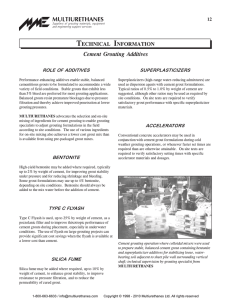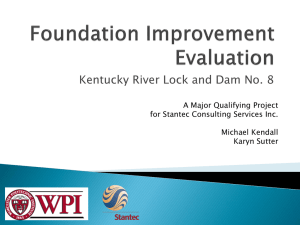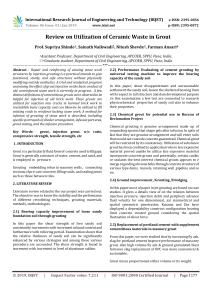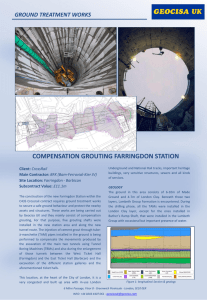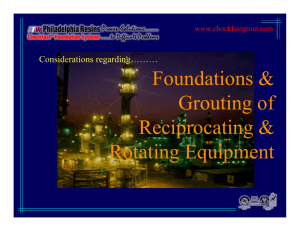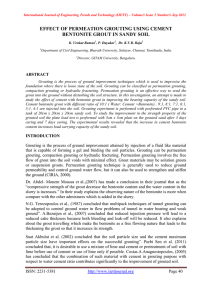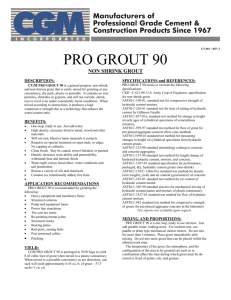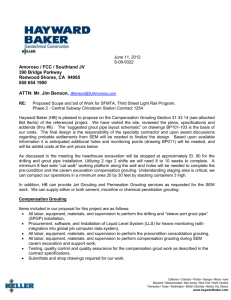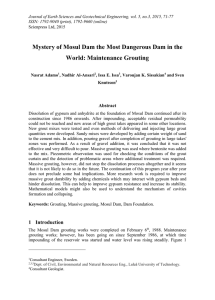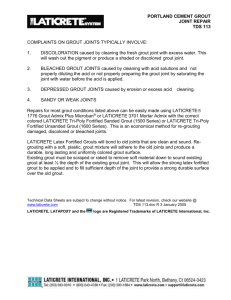Cement Grout Additives (Foam, Fly Ash, Slag and
advertisement
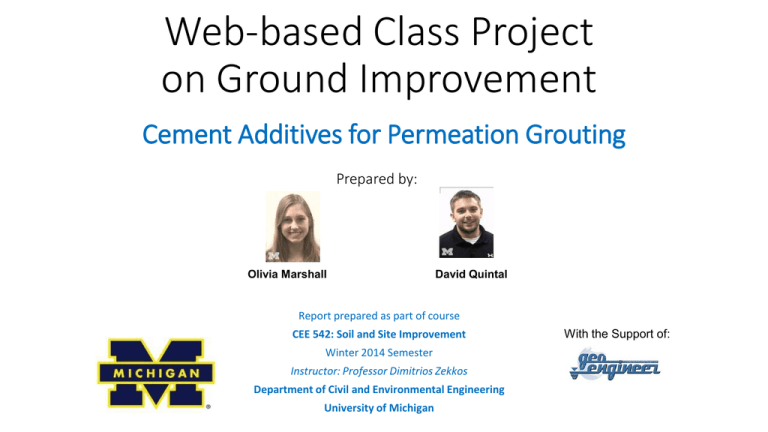
Web-based Class Project on Ground Improvement Cement Additives for Permeation Grouting Prepared by: Olivia Marshall David Quintal Report prepared as part of course CEE 542: Soil and Site Improvement Winter 2014 Semester Instructor: Professor Dimitrios Zekkos Department of Civil and Environmental Engineering University of Michigan With the Support of: More Information More detailed technical information on this project can be found at: http://www.geoengineer.org/education/web-based-class-projects/select-topics-in-groundimprovement Cement Grout Additives (Foam, Fly Ash, Slag and Silica Fume) By David Quintal and Olivia Marshall CEE 542 April 21, 2014 Introduction - Grouting • Injected into the ground to: o o • • o Improve stability and strength Fill voids Water or contaminant control Composed of cement and/or chemicals and other admixtures Permanent Introduction - Cement Additives • • Additives in cement grout can: o Improve strength o Reduce permeability o Reduce cost o Impact set time We considered: o Foam o Fly Ash o Slag o Silica Fume Foam (Cellular) Grout • • • Foaming agent used to create voids Density ranges from about 30-80 pcf 28-day compressive strengths of 50-1200 psi Foam (Cellular) Grout Advantages ● Free flowing (easy to pump, fills small voids) ● Does not require compaction ● Absorbs energy ● Frost resistance ● Good thermal insulation ● Variable density and strength Disadvantages ● Low strength ● High compressibility ● If placed below the water table, the foam grout must be dense enough to displace the water Foam (Cellular) Grout Applications • • • • • Energy absorption Low density backfill material Sliplining Tunneling Stabilization Foam (Cellular) Grout Sinkhole Remediation in Hillsborough Florida • • Grout only needed to be slightly stronger than the soil 40-60% grout/foam mixture resulted in a 20-25% cost savings Fly Ash • • • • By-product of coal combustion Tiny glass spheres contain silica, alumina and calcium Similar particle distribution to Portland cement Two main types, class C and class F Fly Ash Advantages ● Low cost ● Reduces heat generation during curing ● Provides chemical stability ● Reduces permeability ● Increases flowability/pumpability ● Reduction of shrinkage upon drying Disadvantages • • Reduced compressive strength Delays setting time Fly Ash Applications • • • • Partial cement replacement for high volume applications Sliplining Positive environmental implications Backfill around tunnel liner o Channel tunnel backfill grouting in the UK Blast Furnace Slag • • By-product of iron Will activate with the addition of Portland cement Blast Furnace Slag Advantages: • • • • • • • Increase strength Low cost Good cohesion Sulfate resistance Ability to immobilize harmful substances No harm to environment Delay set time Blast Furnace Slag Applications: Dam foundation treatment Mining fill • • • o Cementing tailings to contain and fill Niagara river tunnel o o o Displaced water Long set time for travel Desired strength, permeability, bleed, viscosity Silica Fume • • • By-product in extraction of silicon or ferrosilicon Very small glassy spherical particles of SiO2 Small amounts added to cement Silica Fume Advantages: Reduces permeability Improves stability and resistance to chemicals Reduces viscosity Reacts rapidly • • • • Disadvantages: Expensive Difficult to handle small particles • • Silica Fume Applications: Underwater grouts Chemically harsh environments (oil wells) Grouted piles - for adhesion and corrosive resistance • • • Conclusions Thank You Questions? References Aitcin, P.-C., Ballivy, and G., Parizeau, R. (1984) “The Use of Condensed Silica Fume in Grouts.” American Concrete Institution, 8, 1-18. Akbulut, S. and Saglamer, A. (2003) “The Effects of Silica Fume in Cement Grouting.” Ground Improvement Volume 7, No. 1, pp. 37-44. Ali, L. and Woods, R. (2009) “Creating Artificially Cemented Sand Specimen with Foamed Grout.” Retaining walls, and Foundations, ASCE, Hunan, China, pp. 95-100. Ali, L. (1992) “Dynamic Behavior of Soils Partially Grouted by Foaming Process.” Summary. <http://sunzi.lib.hku.hk/ER/detail/hkul/2986273> Barnes, A.R. (2009) “Foamed Concrete: Application and Specification.” Excellence in Concrete Construction through Innovation. The Concrete Society, Camberley, UK. pp. 39. Bruce, D. (2005) “Glossary of Grouting Terminology.” J. Geotech. Geoenviron. Engr., 131(12), pp. 1534-1542. “Cellular Concrete.” (2014) <http://betibiza26.tumblr.com/post/75309065230/cellular-concrete> Gause, C. and Bruce, D. A. “Control of Fluid Properties of Particulate Grouts: Part 2 - Case Histories.” <http://www.geosystemsbruce.com/v20/biblio/129%20Control%20of%20Fluid%20Properties%20-%20Part%202.pdf> Henn, R. (2003) “AUA Guidelines for Backfilling and Contact Grouting of Tunnels and Shafts.” Chapter 6 Grout Properties, Chapter 7 Backfilling, pp. 75-87, 122-124. Jefferis, S. and Wilson, S. (2012) “Mine Paste Backfill - The Use of Grouts at Massive Scale.” Grouting and Deep Mixing 2012, pp. 1879-1888. Kaeck, W., Rhyner, F., Lacy, H., and Quasarano, M. (2009) “Grouting of Deep Foundations at the Thames River Bridge.” Contemporary Topics in Ground MOdification, Problem Soils, and Geo-Support, 249-256. McGillivray, R., Williams, W., and Broadrick, R. (2012) “Development of a Response Plan and Grout System For Remediation of Sinkholes.” Grouting and Deep Mixing, ASCE, New Orleans, LA, pp. 1626-1633. Midwest Mole. “Cellular Grouting.” <http://www.midwestmole.com/cellular-grouting.php> Mirza, J. Saleh, K. Roy V. and Mirza, M. S. (1999) “ Use of HIgh Volume Fly Ash in Grouting Applications.” American Concrete Institution, 172, 281-298. Norchem, (2013) “Applications.” Norchem Inc., <http://www.norchem.com/applications-repair-products-mortars-grouts.html> Portland Cement Association. “Green in Practice 107 - Supplementary Cementitious Materials.” Technical Brief. <http://www.concretethinker.com/technicalbrief/Supplementary-Cementitious-Materials.aspx> Ryan, C., Day, S., and McLeod, D. (2003) “Long-Distance Grouting, Materials and Methods.” Grouting and Ground Treatment, pp. 1640-1651. University of Kentucky. (2014) “Fly Ash.” What are Coal Combustion By-Products (CCBs)? <http://www.caer.uky.edu/kyasheducation/flyash.shtml> Vickars, R. and Clemence, S. (2000) “Performance of Helical Piles with Grouted Shafts.” New Technology and Design Development in Deep Foundations, pp. 327-341. Vipulanandan, C. and Kumar, M. (2000) “Properties of Fly Ash-Cement Cellular Grouts for Sliplining and Backfill Applications.” Advances in Grouting and Ground Modification: pp. 200-214. Weaver, K. and Bruce, D. (2007) “Grouting Materials.” Dam Foundation Grouting: Revised Edition, pp. 104-108.
